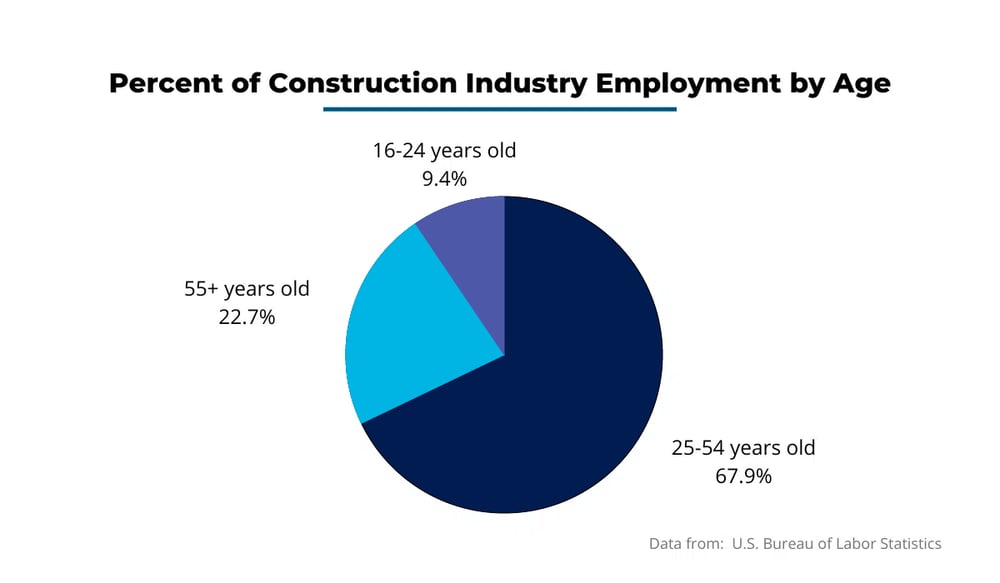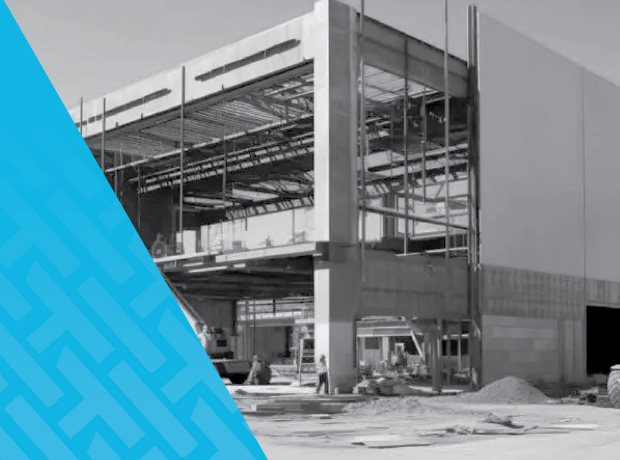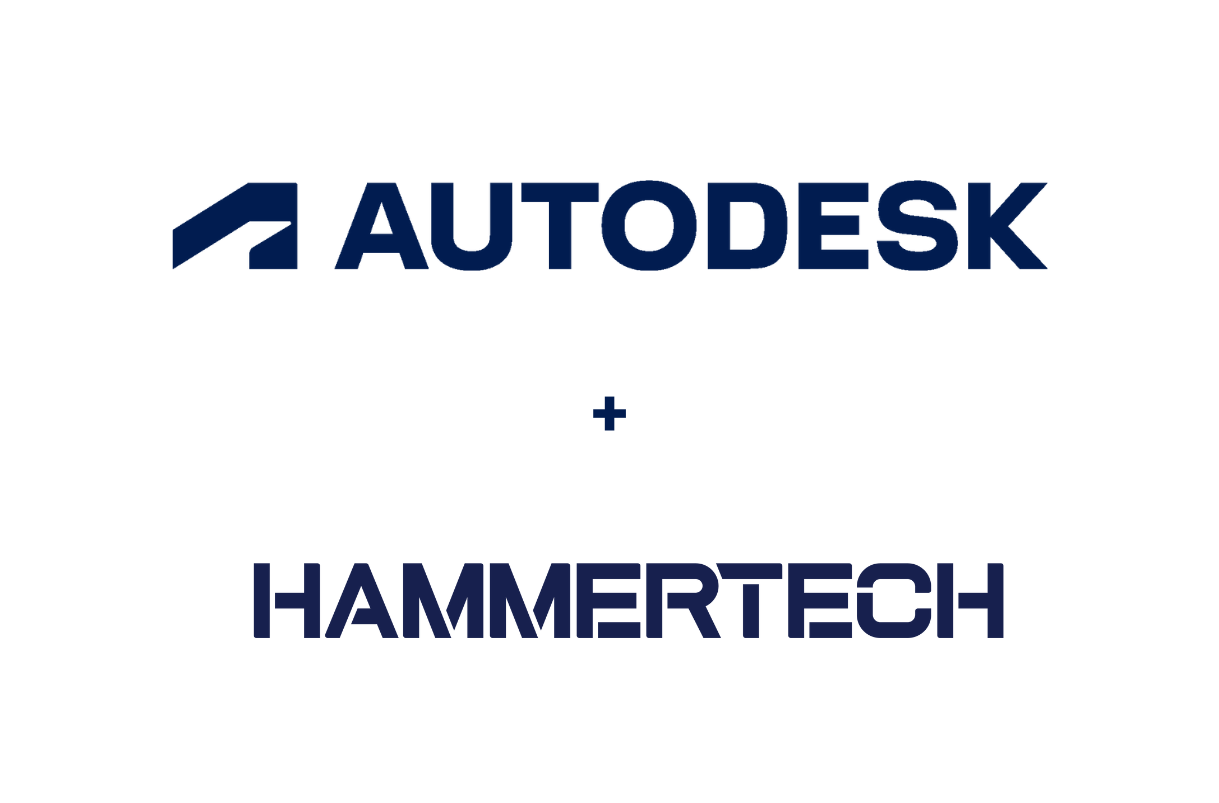What's Inside |
|
|
The Rising Tide: Navigating the Age Shift in Construction
In the coming decades, the construction sector will lose a significant proportion of its skilled workforce with many approaching retirement age. The issue for the sector is that there are not enough young people coming into the industry to replace them.
The latest numbers from the US Bureau of Labor Statistics show that across the country the number of all workers under 25 makes up 13.6% of the workforce. In the construction sector, they make up just 10%. For those over 55, the percentage of workers in that age group has gone from 19.3% in 2015 to 22.3% in 2021. That is almost one in four construction workers across the US being over 55!

And this is not just an issue in North America. Some studies say that within the next decade, 50% of the global construction workforce is due to retire. With few lined up to replace them this could hurt the sector globally.
The Chartered Institute of Building surveyed its global members and found that 76% are aware of the challenges facing the construction sector but only 24% are aware of these issues being taken into consideration on projects. A sense of urgency has not filtered down to the construction sector. The industry needs to do more.
Two things will help alleviate the problem. We all know that construction work takes years to understand and learn to a high standard. With the expected brain drain older workers must pass on their knowledge to those newer to the industry.
Secondly, technology is already having a major impact with the potential to bridge the skills gap. Large construction projects have seen significant gains in safety, efficiency, and productivity. Project management and site safety technology such as HammerTech help to simplify as well as to make the construction process safer.
In the end, an aging workforce shouldn’t just be seen as a challenge, but an opportunity.
Unearthing the Roots: Why Construction's Workforce is Aging
How did we get here? We know that the world’s working population is aging and the lack of younger people coming into the sector is well documented. We believe there are two main reasons for this. Firstly, construction is often not looked at as being a good career. It isn't something that is seen as a stable place to go. Additionally, high schools tend to want their students to go to college so there is little literature available when students are deciding what career to pursue.
Secondly, working in construction wears a body down – and no one wants to retire with a poor quality of life brought about by a worn-out body. Many of the injuries we are seeing in the older workforce are degenerative and built up over time. What could be a relatively innocuous injury for a younger person may take a heavier toll on an older person. That can have an impact on business operations, particularly as older workers are likely to have skills that are needed to guide others on a construction site.
Not everyone is sitting on their hands. We are starting to see companies developing new ways to better cater to an older workforce - whether that be through the introduction of technology or by looking at new ways of working.
Demographic Shifts: A Closer Look at Construction’s Changing Face
The average age of construction workers in the US is 42.5 years according to the US Department of Labor. Seven years ago the average was 40.5 years. In comparison, the average age for all workers in the US increased by less than one year over the same time.
There are challenges on many construction sites with workers from different backgrounds as well as managing a diverse age demographic. We know it is sometimes challenging to get older workers to adopt a new way of doing things. They are also a little more skeptical when it comes to change. That is often the number one concern we find, particularly when it relates to introducing technology. Younger people tend to be more malleable and will embrace change and adapt quickly.
Additionally, everyone learns differently so training should be presented in a variety of ways. Some people are hands-on learners, some are visual, and some are auditory. So just using different media and methods to present your training can help your audience understand the point you're trying to make.
Strategic Solutions: Expert Insights for an Aging Construction Workforce
Embracing Digital Solutions for Enhanced Safety
-
Expert Insight: Companies should leverage technology such as HammerTech to identify and quantify high-risk tasks that are undertaken frequently. Managing your safety with a digital solution saves you time, and paperwork, and provides data to make informed decisions.
-
Application: By understanding the tasks that are done repeatedly, companies can evaluate their safety protocols, ensuring that they aren't overlooking potential risks. HammerTech can also help with:
-
Training and license management: Being able to track worker certificates and expiry dates in an automated matrix to easily avoid lapses.
-
On-going verification of competency in the field: Being able to access licenses and certification information on mobile devices with a simple search using either first or last name, or search for workers by competency.
-
Equipment risk management: Preventing unlicensed workers from operating plant and equipment by linking specific equipment pre-start checklists to competence requirements.
-
Reporting: Generating training matrix reports automatically which highlight gaps and expirations across the workforce pro-actively.
-
On-boarding: Capturing licenses/ tickets/ digitally as part of a worker’s online enrollment.
-
Prioritizing Ergonomics for the Aging Workforce
-
Expert Insight:
We need to be more cognizant of looking after our older workforce and implementing more ergonomic work practices. There are so many new tools and equipment available that are designed to take the strain off workers, particularly repetitive tasks. This is done to prevent cumulative injuries from setting in. We must constantly adapt and innovate in construction practices. -
Application:
-
Replacing a manual task such as lifting heavy wall panels by hand with equipment such as cranes or lifts can drastically reduce physical strain and risk.
-
Carpenters often get carpal tunnel from repetitively swinging a hammer. You can limit their exposure to that task to two hours on and two hours off, or limit the amount of time they are doing that per day.
-
Another example is prefabricating steel on the ground and then lifting it in large units instead of piece by piece. This means no crawling on beams and columns and no weird reaching under.
-
Building the Future: Strategies to Engage Young Talent in Construction
As an industry, we need to start looking at the best way of attracting younger people into our profession. It starts with high schools, but as we mentioned previously, they are often focused on getting their students into colleges and not trades. Colleges usually present to high schools. We should do the same with trades – getting them to speak to students and let them understand that there is another path open to them.
Additionally, many high school students are probably unaware that there is good money to be earned in a trade – and also the potential of owning your own business. There are a lot of opportunities. There also needs to be additional funds allocated to building more trade schools and community colleges. The underlying issue is that school leavers need to be aware there are options.
We also need to change the perception that all you need to work in the sector is a strong back. As many of you will know we are often required to solve a problem and that requires a lot of technical skills – more than a lot of jobs that people are going to college for. If you are a plumber you have to know how to do math and do calculations. It is not just digging and putting a pipe in the ground. Yes, manual labor is often required but that is often a very small portion of what some of these trades require.
Innovating with EHS Software: Harnessing Technology for Workforce Challenges
Adopting technology such as HammerTech enables companies to quantify the exposure level of various types of activities as well as certain tasks to see how many times, for example, we are putting on a pre-task plan that we are going to be lifting today.
There are also tasks that you wouldn’t recognize or realize were risks such as someone picking up moving bags of mortar, for example, and they weigh 50 pounds each. We should know if someone is going to be doing that for three weeks straight. Picking up 50 pounds 25 times a day is tough. HammerTech enables you to quantify that task in a way that you couldn’t previously.
Tracking exertion and output is now possible. So, if at the start of the day, you know you are going to be lifting materials that weigh between 50 and 100 pounds you can quantify it. We can predict how many times they are going to put their body in an awkward position. Once you start identifying these issues you can address them.
So, getting better tools is one solution. Another is where you can make observations. You can do inspections. You can do pre-planning. And you can use those inputs to gather data on these activities and which ones are putting the most strain on your workers.
A lot of injuries come from working on ladders so companies are implementing a Ladder Last program where they are required to use something else like an aerial lift or scaffolding. Such a good example of using data to make a change. We believe we will see this more and more to help reduce the stress on our aging workforce.
As far as policies and procedures go, companies can do a better job incorporating some of the information that's already out there such as those through the National Institute for Occupational Safety and Health (NIOSH). They have, for example, a dedicated ergonomics program that is designed specifically to prevent soft tissue and musculoskeletal injuries. These are usually from repetitive motions, awkward postures, etc. NIOSH is constantly doing research and disseminating information that employers can use to implement change.
Beyond the Horizon: Embracing Opportunities in an Aging Workforce
An aging workforce isn't just a challenge—it's an opportunity. Proper planning and strategies can help harness the potential of experienced workers. An aging workforce does create some risk for our industry and we need to tackle it head-on. There is no use delaying it for another decade as that will make it even more difficult to recover and could have a significant impact on our built environment.
There is a huge opportunity here that we shouldn’t miss out on – and that includes transferring the knowledge from those who have been in the industry for many decades to someone who has only just arrived. We need to keep from getting hurt. We need to take the best practices the older generation has and meld them with what we are learning from new technology.



.png)
.png?width=100&height=100&name=USA%20-%20Worker%20Thumbs%20up%20(9).png) Dylan
Dylan .png?width=100&height=100&name=chris%20gitch%20270x270%20(1).png) Chris Gitch
Chris Gitch 
